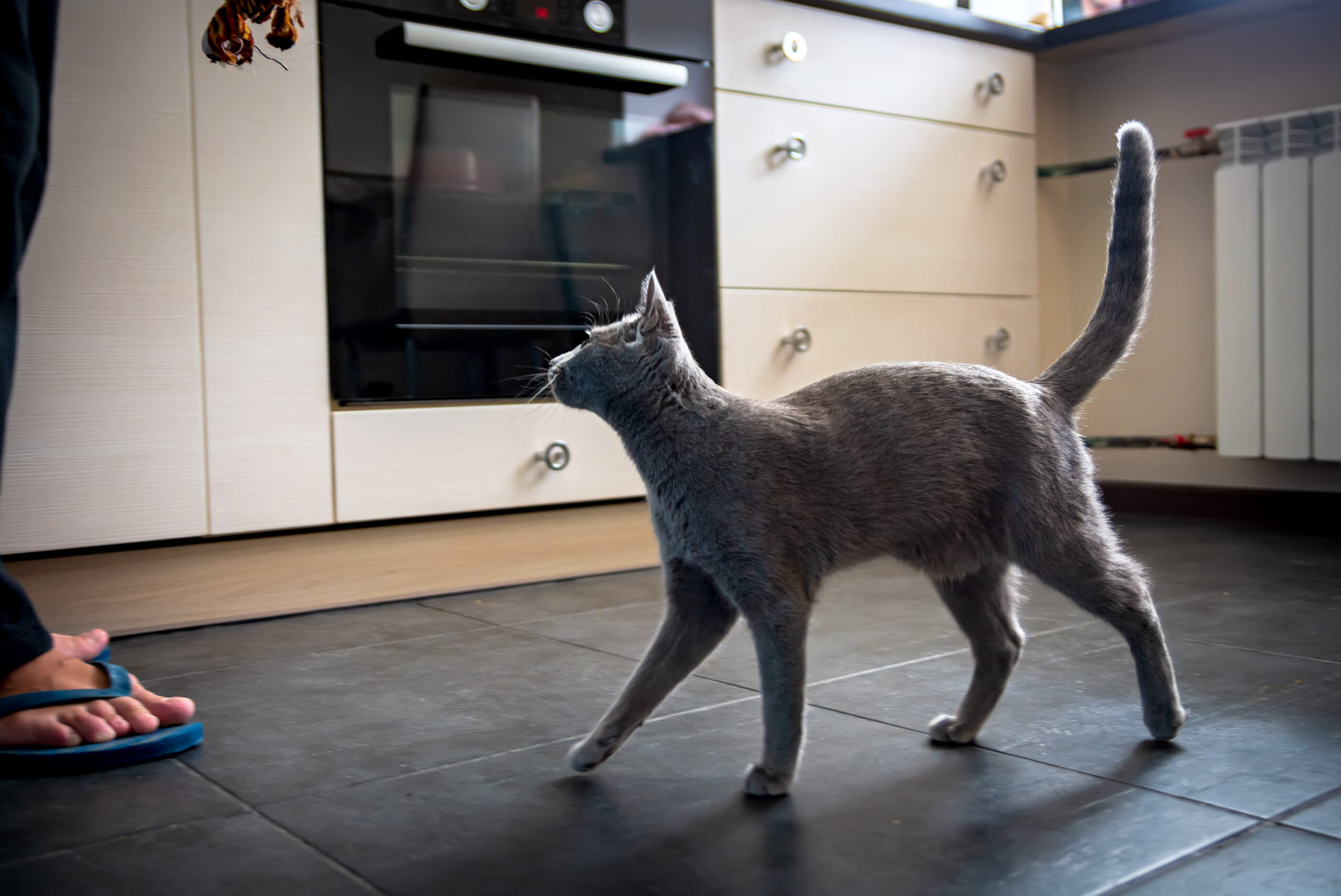What Your Cat’s Tail Is Secretly Trying to Tell You
April 5th, 2022

Cats aren’t expressive and are very challenging to gauge. Right? Wrong. You’ll be amazed at how much you can learn about cat communication by taking the time to observe your feline friend’s body language. The eyes, ears, posture, and especially the tail have stories to tell. Here’s all you need to know about what your cat’s tail is secretly trying to convey.
Cat Tail Positions and What They’re Trying to Say
Cats’ tails have a lot of tales to tell. Watch your feline friend and take note of the tail’s position and the hidden messages it conveys.
- Tail Pointed Straight Up: That’s the perfect way for a cat to demonstrate friendliness. It’s also a sign your cat is happy and approachable.
- U-Shaped Curved Tail: A curved tail is often a sign of relaxation, happiness, or playfulness. The higher the tail goes, the more confidence it demonstrates.
- Tail Wrapped Around You: Touching you with the tail or wrapping it around you is one way your furry friend expresses affection, relaxation, and love. It’s the perfect opportunity for petting your cat and having a play and bonding time.
- Tail Out and Angled Up: If your cat’s tail is held away from the body and slightly angled up, that’s expressing unease or indecision. It’s a wait-and-see situation that could go either way.
- Tail Close to the Body: A low tail held close to the body indicates that a cat feels unsure or afraid. That’s usually not a happy sign, suggesting that aggressive behavior may follow.
- Tail Between the Legs: A tail between the legs isn’t usually good news. It may reflect extreme fear and uncertainty and is a warning that an attack may follow, especially if accompanied by hissing, yowling, and flattened ears.
- Arched or Puffed Out Tail: An arched tail or puffed out tail fur indicates alarm or aggression, regardless of how the tail is positioned. It’s often a way to look larger and more intimidating in the face of a threat.
Cat Tail Movements and What They Convey
Cats communicate through tail movements just as much as their positions. So pause for a moment and watch those subtle cat behaviors, which will tell you a lot about what’s going on with your furry friend.
- Wagging Tail: Unlike dogs, a cat’s wagging tail is not a sign of friendliness. It’s a warning sign expressing anger, fear, or agitation, which may soon be followed by aggressive behavior.
- Slowly Swishing: A tail moving slowly against the ground is a sign of spotting something enticing or getting ready to zero in. You’ll often see the tail thumping against the ground right before pouncing.
- Tail Flicking: In kitty language, flicking a tail tells you to stay clear. It’s a warning sign that your feline friend is angry and ready to go ballistic.
Cat Tail Language: A Recap
Just as it’s important to pay attention to your cat’s tail and what it’s secretly trying to say, you must familiarize yourself with other behaviors, including body positioning and vocalizations. That way, you’ll have a clearer picture of what your cat’s trying to convey.
Still Have Questions?
If you have any questions about your cat’s health or behavior, talk to your trusted team at All About Cats Veterinary Hospital in Kirkland, WA. We’re here to help you decipher your kitty tail language and ensure you engage in the most fulfilling way. We love to support our feline patients and cat owners because, after all, we are all about cats!
Recent Posts
-
Summer Safety Tips for Cat Owners
July 11th, 2024
-
The ABCs of Cat Vaccinations – What Every Cat Owner Should Know
June 5th, 2024
-
Preparing for Travel With or Without Your Feline Friend
May 3rd, 2024
-
How to Feed Cats in a Multiple-Cat Household
April 8th, 2024
-
8 Tips to Get Your Cat in a Carrier
March 5th, 2024
-
Help, My Cat’s Breath Smells!
February 5th, 2024
-
A Quick Guide to Coping with Cat Emergencies
January 8th, 2024
-
Traveling for the Holidays? 6 Things to Do Before Leaving Your Cat
December 14th, 2023
-
What Is Catnip and Is It Safe for Your Cat?
November 2nd, 2023
-
5 Tips for New Cat Owners
October 5th, 2023
-
How Often Should My Cat Have a Health Check?
September 7th, 2023
-
Cat Hairballs – What Do I Need to Know?
August 4th, 2023
-
How to Play with Your Cat: Fun Cat Activities
July 4th, 2023
-
What to Know About Your Cat’s Surgery
June 10th, 2023
-
Licensed Veterinary Technician or Technician Assistant Wanted (Full time or Part time)
May 15th, 2023
-
Why, Oh Why, Does My Cat Hate Water?
May 9th, 2023
-
What’s Wrong with My Cat? Benefits of Whole-Body Radiology
April 5th, 2023
-
Should I Feed My Cat a Grain-Free Diet?
March 6th, 2023
-
Smelly Cat, Smelly Cat – Causes of Feline Odors
February 22nd, 2023
-
5 Ways to Reduce Cat Shedding
January 3rd, 2023
-
Your Cat’s Holiday Stress – How to Help
December 6th, 2022
-
Pet Cancer Awareness Month: Warning Signs to Look Out For
November 2nd, 2022
-
10 Halloween Safety Tips for Cat Owners
October 3rd, 2022
-
Why Is My Cat So Active at Night?
September 7th, 2022
-
Should I Really Microchip My Cat?
August 9th, 2022
-
Ways to Keep Your Cat Safe and Cool This Summer
July 1st, 2022
-
10 Fascinating Facts About Persian Cats
June 1st, 2022
-
How to Correctly Transition Cat Foods
May 6th, 2022
-
What Your Cat’s Tail Is Secretly Trying to Tell You
April 5th, 2022
-
6 Common Household Items That Are Poisonous to Cats
March 1st, 2022
-
How Do I Know if My Cat Needs Dental Surgery?
February 16th, 2022
-
How to Safely Introduce Your Cat to Your New Baby
January 11th, 2022
-
Giving a Cat as a Christmas Gift: How to Do It Responsibly
December 6th, 2021
-
5 Thanksgiving Foods That Are Toxic to Cats
November 5th, 2021
-
Is My Kitty Depressed? Signs to Look For in a Sad Cat
October 7th, 2021
-
Training Tips for New Kitten Owners
September 7th, 2021
-
Taking Your Cat to the Vet: How to Make It a Stress-Free Experience
August 6th, 2021
-
The Origins and History of the Tabby Cat
July 13th, 2021
-
We are hiring a Veterinary Technician!
July 12th, 2021
-
Kitty Claw Control: How and When to Cut Your Cat’s Nails
June 7th, 2021














